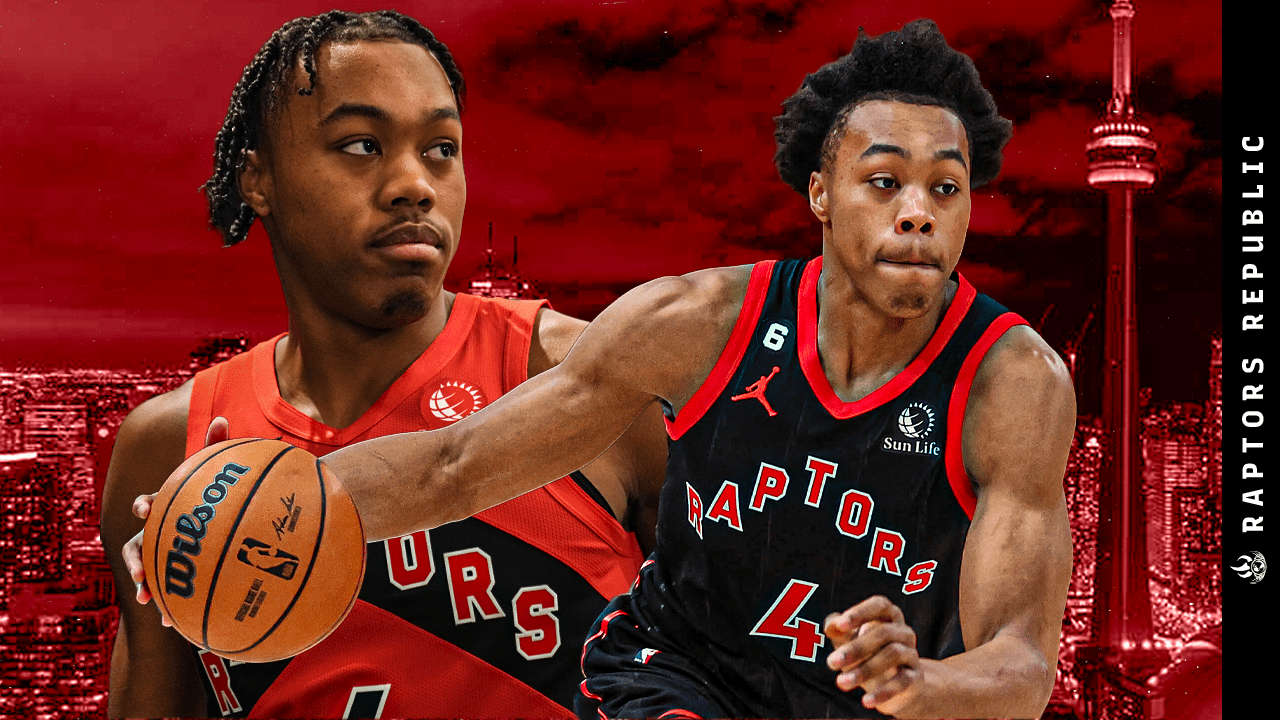It happened early in the third quarter of an otherwise ho-hum preseason game. Jakob Poeltl ambled towards Scottie Barnes and set a pick on the wing. All was normal. Until Barnes exploded.
He took one dribble towards Poeltl’s right shoulder, fitting fairly snugly around the screen. The defender did nothing to respond and smashed into Poeltl, dying on the play. JaVale McGee, playing in drop, stepped up, preparing for Barnes to turn his back and play bully ball, as he usually does. Instead, Barnes bent low to the ground to pound a tight lefty dribble, rocketed past McGee into the lane, and finished a huge dunk off one foot while wearing McGee as a backpack.
You can think of a ‘corner’ in an NBA game as a moving plane, a straight line created by the defender’s hips. As the defender shifts to stay in front of the offensive player, that line moves with him. It is often the Rubicon of an NBA offense — the point of no return. If the ball passes a defender’s hips, the offensive player has officially turned the corner. Then the defense must scatter, rotate, collapse, panic. Everyone’s assignment changes. The offense reaps huge rewards almost immediately. The player with the ball finds easier chances to score, an easier lane to the rim, more open passing lanes for more efficient shots for more teammates.
Turning the corner is the Big Bang of a single offensive possession; where once there was nothing, now there is everything.
And the Raptors were one of the worst ‘corner-turning’ teams in the league last year. Fred VanVleet’s inability to get past Nikola Vucevic’s hips and turn the corner after the Chicago Bulls started switching was at least as big a cause of Toronto’s disastrous play-in collapse as a child’s screaming. Gary Trent jr. has trouble turning the corner. Barnes rarely managed to do so — which was a major takeaway of Samson’s magnum opus. O.G. Anunoby can turn the corner, but he hasn’t been very threatening after doing so — frequently losing his balance, committing offensive fouls, or lofting up poor shots.
According to Second Spectrum, last year Toronto had the 28th-ranked points per chance as a team on drives, ahead of only the Detroit Pistons and Charlotte Hornets. They were 21st in rate of drives that ended at the rim and 27th in efficiency on those attempts. Other than Pascal Siakam, who was excellent, the Raptors continually failed to turn the corner. They were a habitual line-non-stepper.
If Barnes can start to cross the Rubicon with regularity, it will be a revolutionary boon to Toronto’s offense. I’ve been writing about their failure to turn the corner for a while. Last year, Toronto was 29th in drives per 100 possessions that reached the paint out of picks and 28th in efficiency on those plays. For most teams, that was an above-average approach to scoring points. For Toronto it was solitary, poor, nasty, brutish, and short when it happened.
The Raptors saw only eight pick and rolls last year in which the ballhandler finished the play with a dunk. Significantly, four were created by Barnes.
But none of those four were traditional corner-turning picks — which Barnes did in the preseason game against Sacramento. He slowed down, turned his back, used bumps on the ground, rejected screens, or faced broken help defenses. All are good approaches! But they’re not as replicable as simply beating a traditional drop defense by turning the corner with speed. Which is (charitably) what Sacramento was running. Yes, it is preseason. But it’s still incredible to see. Preseason is of course not a real NBA contest, but it could be meaningful to note that Barnes succeeded in a manner that has evaded him to this point. Perhaps. Maybe it’s nothing. But we’ll have to watch more preseason games to see. All things started off on the right foot, though. And it wasn’t the only sign of progression.
Some benefits to turning the corner with speed rather than bully driving: The offensive player hits the paint with momentum, giving him the opportunity to jump into a shot — leading to the opportunity for layups or dunks. The offensive player keeps more defenders engaged and allows less of a chance for orbital defenders to recover. The offensive player has more passing lanes available. You get the point. It’s helpful.
That one play fit with a general theme of activity, aggression, and commitment to reaching the rim from Barnes. He attempted seven free throws — an amount he only matched or exceeded in 18 games in his career to date. And he was thunderous in his rampages to the rim, at points taking on the entire Kings’ roster in transition.
Barnes was phenomenal against Sacramento last year, averaging 10 assists per game in two contests, and scoring 27 in the first game between the two clubs. So we shouldn’t freak out about a 15-point output in an exhibition game. And Sacramento especially gave Barnes perhaps the most room for success in the pick and roll of any defensive team last year — he averaged his highest pick-and-roll points per chance against them of any team, at 1.6. The Kings switched virtually every pick Barnes ran, and he feasted against Sacramento’s relatively small defense. But again: his success in preseason came in a different, more replicable way — at least on that one play.
Barnes will have a new role this year, and if he — or someone else — doesn’t manage to find a way to cross the Rubicon and bang down the gates to Rome (the rim), the team will struggle. So Barnes’ ability there will be a hinge upon which the season will swing. All this to say: It’s a good start to a new era.



